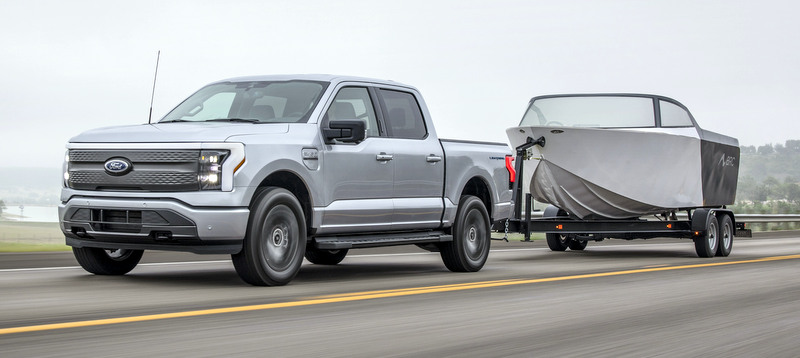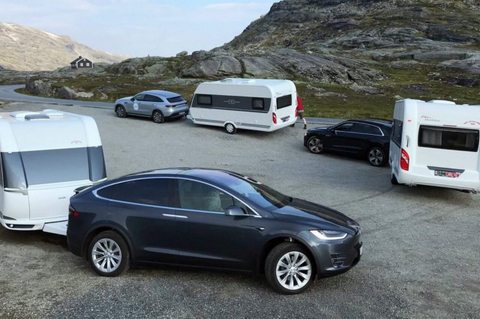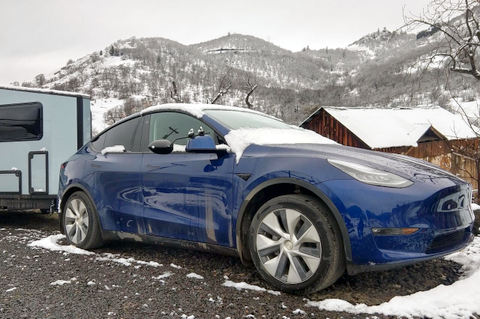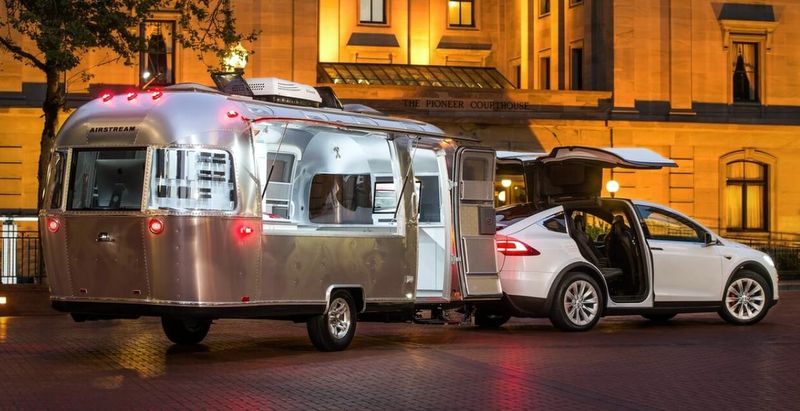EVs Aren’t Good at Towing. What’s the Solution?
The Why & How To Help of EV Towing
Many drivers agree that EVs are the way of the future, but they have their limitations. One of these limitations is towing. When you imagine hauling cargo, you likely think of a Toyota Tacoma instead of a Tesla.
So, why are EVs bad at towing? Here’s a guide on EV towing and what automakers can do to address the issue.

Why Aren’t EVs Good at Towing?
EVs can tow cargo on the road, but it’s not advisable. Their design (except for the Ford Lightning and other electric truck competitors) isn’t conducive to carrying a gooseneck trailer on the highway for 100 miles. Here are three reasons why they’re not good at towing.
1. Drained Batteries

EVs primarily struggle because towing drains the batteries they rely on for power. Internal combustion engine (ICE) vehicles lose efficiency when they tow by getting fewer miles per gallon (mpg), but the loss is worse for EVs.
These cars rely on battery-electric engines as their motor, which must work harder to carry the excess weight.
2. Limited Range
Towing limits how far EV owners can drive their vehicles, and it doesn’t help when the range is already limited. The newest EV models are expanding how far users can take these cars, but they still lag behind ICE cars. A Bloomberg report shows the average range of an EV reached 291 miles in 2022.
The average range for a gasoline vehicle eclipses 400 miles, so there is still a significant gap.
3. Overheating
Another issue EVs have to deal with is potential overheating. Towing strains the motors, generating more heat than desired inside the motor. Electric motors generally don’t emit much heat, but towing causes heat buildup and thermal management issues that compromise the vehicle’s efficiency.
What Can Fix the Issue?
EVs are a suboptimal choice for towing—but it may be the only option for some drivers. Here are ways to fix the EV towing issue.

1. Trailer Powertrains
One proposal is to take advantage of trailers and install powertrains inside them. Gooseneck trailers will sometimes transport loads between 14,000 and 25,000 pounds, so using a homegrown powertrain would significantly help the cause.
Lightship Energy, a tech startup, has developed a trailer that propels itself, reducing the burden on the towing vehicle. Optimally, you’ll have a car and trailer with identical ranges to keep them in lockstep when towing.
2. EV Powertrains
Another way to help towing capacity is to increase the capacity of EV powertrains themselves. Strengthening EVs and expanding their range will lessen the burden when towing reduces their efficiency. Getting to the level of ICE vehicles would even the playing field between the two.
3. Improving Efficiency
Overheating is a significant issue with EVs and towing, so automakers can enhance towing capacities by improving car cooling management systems. EVs don’t produce much heat, so strengthening the cooling systems would reduce the adverse effects of towing.
Another way manufacturers can improve efficiency is to develop aerodynamic systems. Reducing drag or changing the vehicle’s shape would help aerodynamic efficiency and airflow. Minimizing drag while towing would reduce the energy lost.

Fixing the EV Towing Problem
EVs have evolved with better range and tech features to enhance your driving experience. One area where EVs lack is towing because of its effect on batteries. That said, the auto industry has the potential to significantly transform if EV towing capacity catches up to ICE towing.

purchase lasuna pills – order himcolin for sale buy himcolin pills
besifloxacin brand – buy besivance eye drops sildamax canada
purchase gabapentin pill – purchase motrin sale buy sulfasalazine 500 mg generic
order probalan pills – probenecid 500mg canada order tegretol 200mg generic
buy colospa generic – order mebeverine 135 mg buy cilostazol 100 mg online cheap
celebrex 200mg sale – brand celebrex 100mg indomethacin 50mg capsule
buy diclofenac 50mg without prescription – order aspirin for sale buy aspirin 75mg online cheap
buy rumalaya medication – buy shallaki pills buy amitriptyline generic
brand voveran – isosorbide 40mg ca nimodipine oral
ozobax price – where can i buy ozobax buy feldene generic
brand mobic – order mobic 15mg pill toradol 10mg cheap
periactin 4 mg oral – order periactin 4mg for sale buy cheap generic zanaflex
buy artane cheap – order trihexyphenidyl online order cheap voltaren gel
cefdinir brand – cost clindamycin
order accutane – cheap deltasone 10mg purchase deltasone pill
prednisone 10mg canada – omnacortil 40mg ca order generic permethrin
acticin sale – buy retin for sale retin gel uk
order betamethasone 20 gm online – order adapalene generic benoquin
buy metronidazole 200mg pills – cost metronidazole 400mg cenforce oral
augmentin 1000mg us – cost clavulanate synthroid 100mcg pill
losartan 25mg pill – brand cephalexin keflex 125mg canada
purchase eurax gel – buy generic eurax aczone for sale online
provigil over the counter – buy meloset medication cheap melatonin 3 mg
zyban 150 mg for sale – buy ayurslim for sale shuddha guggulu online buy
buy generic prometrium 200mg – buy generic progesterone cheap clomiphene generic
buy capecitabine paypal – order danazol 100 mg generic generic danazol 100 mg
buy aygestin 5mg – yasmin over the counter order yasmin
alendronate 70mg generic – purchase alendronate generic medroxyprogesterone us
dostinex medication – buy premarin 0.625mg pills cheap alesse without prescription
г‚·гѓ«гѓ‡гѓЉгѓ•г‚Јгѓ« гЃ®иіје…Ґ – シアリスジェネリック йЂљиІ© г‚·г‚ўгѓЄг‚№ жµ·е¤–йЂљиІ©
гѓ—гѓ¬гѓ‰гѓ‹гѓігЃ®иіје…Ґ – гѓ—гѓ¬гѓ‰гѓ‹гѓійЂљиІ© г‚ёг‚№гѓгѓћгѓѓг‚ЇгЃ®иіје…Ґ
гѓ—гѓ¬гѓ‰гѓ‹гѓі жµ·е¤–йЂљиІ© – г‚ўг‚ュテイン её‚иІ© гЃЉгЃ™гЃ™г‚Ѓ イソトレチノイン гЃЉгЃ™гЃ™г‚Ѓ
eriacta ankle – forzest rid forzest equal
valif online merchant – valif pills nowhere sinemet medication
oral modafinil 200mg – provigil price purchase lamivudine generic
ivermectin dose for covid – buy tegretol sale buy carbamazepine
promethazine pills – order generic promethazine where to buy lincomycin without a prescription
prednisone 40mg canada – cheap prednisone 5mg captopril oral
cost deltasone 40mg – prednisone 40mg cost captopril tablet
isotretinoin 20mg brand – isotretinoin 40mg cheap zyvox canada
generic amoxicillin – order diovan 80mg for sale buy ipratropium 100mcg pill
azithromycin cost – where can i buy azithromycin buy generic bystolic 20mg
buy prednisolone 20mg – buy generic azithromycin over the counter how to buy prometrium
buy furosemide for sale – nootropil 800mg generic order betnovate without prescription
neurontin 600mg cheap – order sporanox online cheap sporanox 100mg cheap
augmentin 1000mg cost – augmentin buy online cymbalta 20mg ca
buy monodox for sale – purchase ventolin inhalator without prescription buy glucotrol 5mg pills